Martin Edwards's Blog, page 159
July 15, 2016
Forgotten Book - The Colour of Murder
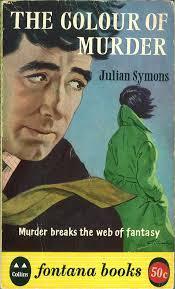
Julian Symons' The Colour of Murder won the CWA's "Crossed Red Herring" award in 1957; in other words, what is now known as the CWA Gold Dagger for the best crime novel of the year. Quite an accolade, and you might think that, especially given Symons' stature in the crime world, the book would hardly qualify as "forgotten". But it's seldom been discussed, and I must admit that although I read it in my youth, even I'd allowed the story to slip from my memory.
When I picked up a copy on my birthday last week, I wondered how well it would stand up to scrutiny, almost six decades after publication. Rather casually, I started reading, and I soon found myself hooked. I have an awful lot of good books on my TBR pile, but The Colour of Murder demanded to be read, even though in one or two respects it resembles certain of Symons' other books (a real favourite of mine, The Man Whose Dreams Came True, springs to mind, though I should add that there are also many differences between the novels).
John Wilkins is an unhappily married man who suffers occasional blackouts. The first part of the book amounts to a statement that he gives to a psychiatrist, so it is fairly clear that he has been charged with murder. But of whom? His awful wife May is an obvious candidate, not least because Wilkins fancies a librarian called Sheila. The suspense builds relentlessly as Wilkins chronicles his own downfall.
The second part of the story details what happens after murder is committed. There's a lengthy trial scene - Symons was very good at those - and a nice twist at the end. There's really a great deal to enjoy in this story, especially Symons' sceptical view of the nature of justice. He was in many ways the heir to Anthony Berkeley in the way he exposed the fallibility of our legal system, and managed to make readers interested in the plight of people who are very far from perfect, such as Wilkins. An added bonus is the crisp portrayal of Fifties Britain, with its snobberies and its taboos vividly displayed. A first rate novel, which I enjoyed more on this second reading than I did the first time around, which was in the days when I was more interested in ingenious whodunits than novels of character and society. As I say, this book does have a neat plot, but it offers a good deal more than that...
Published on July 15, 2016 01:30
July 13, 2016
Fear Island - film review
Fear Island is a 2009 thriller film which mixes some familiar plot elements with a structure slightly suggestive of The Usual Suspects. It really isn't in the same league as the more famous film, and some of the reviews I've read on the internet are very negative. But for me, it's a perfectly watchable movie, short and pacy enough to maintain interest.
We start off with a young woman, Jenna (played by Haylie Duff) emerging as the only survivor from a group of six people who had gone on a party break on a seemingly idyllic island. A grumpy detective treats her as the prime suspect, but a female doctor appointed to the case by the D.A. takes a more sympathetic view, as Jenna recounts what has happened in instalments, as her memory comes back to her.
In other words, this is a flashback story, and as many writing guides make clear, flashbacks are tricky devices to handle. On the whole, I thought the screenplay managed the switches between past and present pretty well. I came up with a theory about the case after only five minutes, but happily it proved wide of the mark, and although one of the main plot twists was predictable, another one - although by no means original - was neatly handled.
The cast isn't exactly star-studded, and I didn't think they managed to engage the viewer's emotions as well as would have been desirable. Films such as In Fear and Eden Lake do this much better, in my opinion. It always helps if one can identify closely with the plight of characters who are being terrorised, and I didn't feel that level of empathy here. But the plot passed muster, and it's not by any means a bad example of this type of film. Overall, I'm glad I watched it.
We start off with a young woman, Jenna (played by Haylie Duff) emerging as the only survivor from a group of six people who had gone on a party break on a seemingly idyllic island. A grumpy detective treats her as the prime suspect, but a female doctor appointed to the case by the D.A. takes a more sympathetic view, as Jenna recounts what has happened in instalments, as her memory comes back to her.
In other words, this is a flashback story, and as many writing guides make clear, flashbacks are tricky devices to handle. On the whole, I thought the screenplay managed the switches between past and present pretty well. I came up with a theory about the case after only five minutes, but happily it proved wide of the mark, and although one of the main plot twists was predictable, another one - although by no means original - was neatly handled.
The cast isn't exactly star-studded, and I didn't think they managed to engage the viewer's emotions as well as would have been desirable. Films such as In Fear and Eden Lake do this much better, in my opinion. It always helps if one can identify closely with the plight of characters who are being terrorised, and I didn't feel that level of empathy here. But the plot passed muster, and it's not by any means a bad example of this type of film. Overall, I'm glad I watched it.
Published on July 13, 2016 13:58
Celebrating Sergeant Cluff
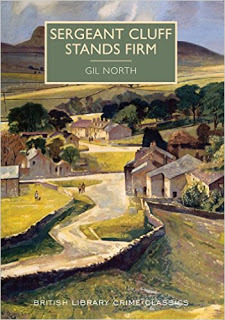
Yesterday saw a very enjoyable launch event at the Grove Bookshop in Ilkley of the latest British Library Crime Classic. The book we were celebrating was Sergeant Cluff Stands Firm, by Gil North, the first novel in North's Yorkshire-based series. September will see the publication of a second book in the series, The Methods of Sergeant Cluff.

I'd got in the mood for the event by touring round scenic spots in Yorkshire, including Skipton, which North fictionalised as Gunnarshaw, Cluff's base. Landscape plays an important part in the books, and I enjoyed visiting Malham Cove, climbing a long way up to the fantastic viewpoint on the Limestone Pavemetnt, and taking a look at lovely Malham Tarn.


The Gil North books represent something of a departure for the British Library, because they were published in the Sixties, rather than during the Golden Age of Murder between the wars (at least that's how I define the Golden Age,but really it's a concept that means different things to different people). But the Library takes the view that books that are more than 50 years old are certainly eligible to be considered as examples of Classic Crime, and that seems spot on to me..
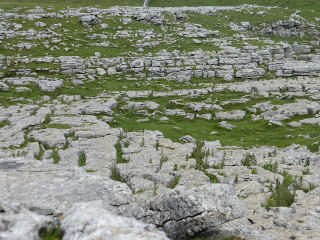

I have a very, very distant memory of my father watching the Cluff TV series when I was a small boy. Yes, Cluff was a telly cop! He was played by Leslie Sands, well cast as the dour but compassionate Dalesman. The TV series was written by North, and enjoyed considerable popularity, but of course even TV fame is relatively transient. It's good to see these books - clearly influenced by Simenon in terms of style and approach - back in print.


Gil North was a pen-name for Geoffrey Horne, an interesting character about whom I learned a good deal from talking to his son Josh before writing my intros to the two books. I was sorry Josh was unable to attend the launch, but it was good to spend time with Rob Davies of the British Library, Peter Crangle, who represents the estate, and an enthusiastic audience including Catherine, alias that splendid blogger Juxtabook. We missed Lisa Shakespeare of Midas PR, who has been very busy n generating interest in Cluff, but I hope our paths cross before long. Perhaps at the Ilkley Literary Festival in October, to which I've been invited, and where I'll be talking about Cluff and Classic Crime (and a bit about my own books) in October. Really looking forward to it.
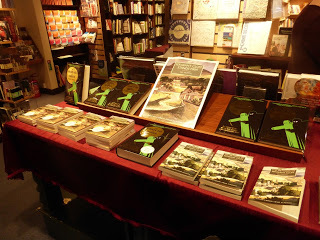
Published on July 13, 2016 04:26
July 11, 2016
The Writing Life - and Taking a Break From It

When I was working full-time as a partner in a law firm, holidays were limited, and even when I was away, it was very difficult to escape the burdens of business. Life is different now I'm a part-time writer, and I'm very glad about that, but the question of when and how to take a break from writing is (in a different way) at least as important. Many years ago I read an essay by Len Deighton, which I've never forgotten, in which he said he wrote every day - even on Christmas Day. (The essay was to be found in an entertaining and informative book put together by Harry Keating called Who-dun-it?) I certainly don't manage to emulate Len, but I do feel that taking a break from writing can really help - somehow - to get one's story ideas into shape.
Considerations like these were in my mind last week, when I celebrated my birthday. You could say that I've reached the age when one should not dwell too much on birthdays, but I believe the opposite: it's time to make the most of them! So in recent years, even when I was office-based, I have taken the day off and gone an interesting trip. The result has been plenty of memorable birthday adventures.

So it was this year, when - having warmed up for the celebrations with a trip to London to see a fabulous concert at the Royal Festival Hall with the ageless Burt Bacharach and Joss Stone - I headed off to North Wales. One of Cheshire's many advantages is that it's an excellent base for exploring lots of fantastic destinations within an hour or so's drive, and one of them is Llangollen, a gorgeous town.

Llangollen boasts a very large second hand bookshop there, and I started my trip by making a few acquisitions, books by Helen McCloy, Edgar Lustgarten, and Julian Symons. Then, as the sun made an appearance, it was on to the steam railway for a trip along the Dee Valley. This journey reminded me of my last steam railway trip, in the Ardeche region of France (below) during a stop off on a short cruise on the river Rhone that I undertook recently.


Next stop was a UNESCO World Heritage Site, Pontcysllte Aqueduct, which is the highest navigable aqueduct in the world, It's a pleasantly dizzying experience to walk along the narrow path beside the canal, far above the valley.


Again it put me in mind of the trip to France, and a visit to another amazing aqueduct, Pont du Gard, (below) which was built by the Romans rather than by Thomas Telford. Two wonderful places, both strongly recommended.


My birthday afternoon finished up with tea at Chirk Castle, followed by dinner overlooking another canal, this time in Lymm, and then a chance to get stuck in to Symons' The Colour of Murder, a highly enjoyable book that I hope to discuss on this blog on Friday. And whilst I didn't get any writing done, the pleasure of doing something different certainly seems to me to be helpful in terms of writing. A chance to relax gives your subconscious a chance to untangle one or two of those knotty plot problems that you've been struggling with. And so it proved last week. .


Published on July 11, 2016 06:27
July 8, 2016
Forgotten Book - The Necessary Corpse
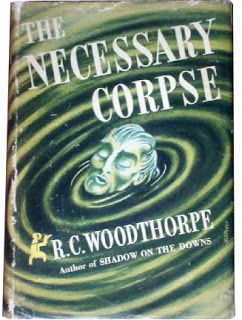
R.C. Woodthorpe is a writer I find intriguing. He burst on to the scene in the Thirties with successful books such as The Public School Murder, and his work demonstrates an ability to characterise well, and to amuse. He had a great interest in politics and social issues, and his novels reflect this. Unfortunately, The Necessary Corpse, first published in 1939, illustrates his shortcomings as a writer, as well as his strengths.
The story begins in lively fashion. Quinton, a rich entrepreneur who has built up a highly successful retail empire, receives a letter threatening his life. He has arranged to meet Nicholas Slade for lunch, and Slade saves his life when someone tries to shoot him. (We are reminded that William Whiteley founder of the famous department store, was himself murdered.) Quinton and Slade take refuge with a group of "Progressive Thinker", and discover that Quinton's right-hand woman is actually a freelance journalist with left wing and anti-capitalist views. The complications increase as it becomes clear that a trio of American gangsters are out to murder Quinton, and they won't be satisfied until he is dead. He could fake his death, yes, but how to provide "the necessary corpse"?
This is not a detective story but a light thriller, and - as usual with Woodthorpe - the emphasis is more on comedy with a political edge than on plot. Whenever I read a Golden Age story in which American gangsters make an appearance, I cringe, since they offer a kind of reverse kite mark, an indication that the book won't have even a pretence of realism. This was Woodthorpe's first published novel for four years, and I wonder if the gap arose because he struggled to find a good idea for a plot.
Slade, a sleuthing novelist who made an interesting debut in Silence of a Purple Shirt, seems rather subdued here, and it is not really a surprise that he never appeared in another novel. Woodthorpe is more interested in the relationship between Quinton and his feisty sidekick. There are some good lines, not least about journalism, but overall the novel is a disappointment. Woodthorpe's wit and intelligence don't compensate for the weakness of the story.
Published on July 08, 2016 03:48
July 6, 2016
Secret Beyond the Door -film review
Secret Beyond the Door is a 1948 film, directed by the estimable Fritz Lang. It's based on a book published a couple of years earlier called Museum Piece No. 13, written by Rufus King, an American detective novelist. I haven't read the book, but King was an interesting author and I hope to say more about him on this blog in due course. As for the film,it's entertaining and well worth a watch.
The plot seems, on the surface, to follow a familiar pattern. A pretty young woman who has inherited money but is in search of love goes off on holiday to Mexico and falls in love with a man who notices her interest in a knife fight. There's a hint at this stage that her psychology is rather twisted, but I don't think it's a spoiler to say that this angle of the story is not really followed up. She marries the chap after a whirlwind romance,and then her troubles really begin.
In many respects, this is a classic "woman in jeopardy" film, but there are elements in the story which strengthen its appeal. The casting is very good - Joan Bennett and Michael Redgrave (who was very good in creepy parts) are the seemingly ill-matched couple, while Anne Revere, as the husband's sister, and Barbara O'Neill, as his secretary, also contribute to the mysterious goings-on. The big question is - what lies behind a door that Redgrave keeps locked? I guessed the answer, but there is another pleasing plot twist at a later point, and the outcome of the story is not what you might expect.
Lang was a gifted director, and here he makes excellent use of the plot material, even though some of the effects - dramatic storms, and so on - are rather conventional, others are quite striking. The film's producer was Walter Wanger, who was one of Bennett's husbands. They seem to have been an odd couple in their own right. Three years after this film was made, Wanger shot Bennett's agent, whom he suspected of having an affair with her. The scandal, she reckoned, ruined her career, although they remained married for more than a decade. She married again and lived to the age of 80. She's best known for her appearance in certain other movies in the film noir vein, but this one doesn't deserve to be overlooked.
The plot seems, on the surface, to follow a familiar pattern. A pretty young woman who has inherited money but is in search of love goes off on holiday to Mexico and falls in love with a man who notices her interest in a knife fight. There's a hint at this stage that her psychology is rather twisted, but I don't think it's a spoiler to say that this angle of the story is not really followed up. She marries the chap after a whirlwind romance,and then her troubles really begin.
In many respects, this is a classic "woman in jeopardy" film, but there are elements in the story which strengthen its appeal. The casting is very good - Joan Bennett and Michael Redgrave (who was very good in creepy parts) are the seemingly ill-matched couple, while Anne Revere, as the husband's sister, and Barbara O'Neill, as his secretary, also contribute to the mysterious goings-on. The big question is - what lies behind a door that Redgrave keeps locked? I guessed the answer, but there is another pleasing plot twist at a later point, and the outcome of the story is not what you might expect.
Lang was a gifted director, and here he makes excellent use of the plot material, even though some of the effects - dramatic storms, and so on - are rather conventional, others are quite striking. The film's producer was Walter Wanger, who was one of Bennett's husbands. They seem to have been an odd couple in their own right. Three years after this film was made, Wanger shot Bennett's agent, whom he suspected of having an affair with her. The scandal, she reckoned, ruined her career, although they remained married for more than a decade. She married again and lived to the age of 80. She's best known for her appearance in certain other movies in the film noir vein, but this one doesn't deserve to be overlooked.
Published on July 06, 2016 13:52
July 4, 2016
It's Always Handy to Have Another Hat - Paul Charles on the Writing Life
Pursuing this blog's interest in the writing life, I'm delighted to host a guest blog from Paul Charles, author of the Christy Kennedy series and a number of other highly enjoyable novels. His theme is one familiar to many writers - that of combining another job with that of authorship. It's not always easy, but the question of how to strike the right balance is, I think, of real interest. Over to you, Paul:
"Recently I bumped into a mate of mine, Martin Edwards, in the USA. Martin’s from Liverpool and I’m an Ulsterman currently exiled in London and our paths crossed in Bethesda, MD, USA at the annual Malice Domestic Crime Writers convention. Martin was on his award-collecting tour and I was out promoting my latest Inspector Starrett mystery, St Ernan’s Blues. It’s always great to see Martin but it’s somehow different when you meet up with a mate by accident on foreign soil. I suppose it’s due to the fact that the time and the connection are more precious or something. Anyway we ensured we’d time for a quick lunch and a catch up chat.
Apart from being crime writers the other thing we share (as Martin reminded me) is that we both have twin careers. He’s a successful solicitor and I’m very fortunate to be an agent in the music business. As Martin pointed out in a recent blog, the other hat we wear has certainly helped us both in various ways with our crime-writing careers.
Also having another “job,” as it were, certainly helps me in my writing in that it permits me to move amongst people unnoticed, while allowing me to observe people in their normal environment to my heart’s content. I’ve always felt that being a celebrity writer must compromise writers somewhat. I suppose what I’m trying to say is that when such a writer enters a room, it’s a bit like a TV camera entering a room. Everyone is very conscious there is a camera – or a famous writer - present and so, without even knowing it, they put on a face, even an accent sometime, and you lose the sense of the real them, of their spirit. I enjoy nothing more than sitting in a restaurant, or a hotel lobby, or an airport terminal,One of my favourite such scenes was one Saturday morning I was sitting in a Helsinki hotel lobby, minding my own (and other people’s) business when a group of glamorous and giggly septuagenarian ladies congregated on the nearby sofas. They were all dressed in various pastoral colours, with pumps (gutties rather than trainers) and bobby socks. With their energy, enthusiasm, obvious love of life, not to mention, their air of devilment it would have been very easy to have mistaken them for a bunch of teenagers were it not for the 70 years of Finnish weather they’d endured. I obviously hadn’t a clue what they were talking about but (even without subtitles) it was one of the most enjoyable foreign “movies” I’ve ever seen.
Another enjoyable hotel scene I recall is a Liverpool one. I was in Liverpool for an Elvis Costello concert and staying at the very famous and still extremely elegant Adelphi Hotel. I spent a few hours drinking endless cups of tea (I’ll also confess to eating a few scones) while these wonderful scenarios unfolded before me. I used some of those scenes pretty much as they happened in The First of The True Believers – my Beatle themed novel.
The Adelphi is also a hotel I imagine Harry Devlin infrequently visiting. Harry Devlin is one of Martin Edwards’ great characters – coincidently Harry is also a Liverpool solicitor. I’ve always been a big fan of the Harry Devlin series and was very happy to hear over my lunch with Martin that it may not be as long as I first feared until Mr Devlin makes a return. I’ve always felt the Harry Devlin series of books are perfect for the small screen and I’m hoping that the next time Martin and I bump into each other again on foreign soil we’ll be discussing, over our lunch, the success of Harry Devlin on TV.."
"Recently I bumped into a mate of mine, Martin Edwards, in the USA. Martin’s from Liverpool and I’m an Ulsterman currently exiled in London and our paths crossed in Bethesda, MD, USA at the annual Malice Domestic Crime Writers convention. Martin was on his award-collecting tour and I was out promoting my latest Inspector Starrett mystery, St Ernan’s Blues. It’s always great to see Martin but it’s somehow different when you meet up with a mate by accident on foreign soil. I suppose it’s due to the fact that the time and the connection are more precious or something. Anyway we ensured we’d time for a quick lunch and a catch up chat.
Apart from being crime writers the other thing we share (as Martin reminded me) is that we both have twin careers. He’s a successful solicitor and I’m very fortunate to be an agent in the music business. As Martin pointed out in a recent blog, the other hat we wear has certainly helped us both in various ways with our crime-writing careers.
Also having another “job,” as it were, certainly helps me in my writing in that it permits me to move amongst people unnoticed, while allowing me to observe people in their normal environment to my heart’s content. I’ve always felt that being a celebrity writer must compromise writers somewhat. I suppose what I’m trying to say is that when such a writer enters a room, it’s a bit like a TV camera entering a room. Everyone is very conscious there is a camera – or a famous writer - present and so, without even knowing it, they put on a face, even an accent sometime, and you lose the sense of the real them, of their spirit. I enjoy nothing more than sitting in a restaurant, or a hotel lobby, or an airport terminal,One of my favourite such scenes was one Saturday morning I was sitting in a Helsinki hotel lobby, minding my own (and other people’s) business when a group of glamorous and giggly septuagenarian ladies congregated on the nearby sofas. They were all dressed in various pastoral colours, with pumps (gutties rather than trainers) and bobby socks. With their energy, enthusiasm, obvious love of life, not to mention, their air of devilment it would have been very easy to have mistaken them for a bunch of teenagers were it not for the 70 years of Finnish weather they’d endured. I obviously hadn’t a clue what they were talking about but (even without subtitles) it was one of the most enjoyable foreign “movies” I’ve ever seen.
Another enjoyable hotel scene I recall is a Liverpool one. I was in Liverpool for an Elvis Costello concert and staying at the very famous and still extremely elegant Adelphi Hotel. I spent a few hours drinking endless cups of tea (I’ll also confess to eating a few scones) while these wonderful scenarios unfolded before me. I used some of those scenes pretty much as they happened in The First of The True Believers – my Beatle themed novel.
The Adelphi is also a hotel I imagine Harry Devlin infrequently visiting. Harry Devlin is one of Martin Edwards’ great characters – coincidently Harry is also a Liverpool solicitor. I’ve always been a big fan of the Harry Devlin series and was very happy to hear over my lunch with Martin that it may not be as long as I first feared until Mr Devlin makes a return. I’ve always felt the Harry Devlin series of books are perfect for the small screen and I’m hoping that the next time Martin and I bump into each other again on foreign soil we’ll be discussing, over our lunch, the success of Harry Devlin on TV.."
Published on July 04, 2016 03:20
July 1, 2016
Forgotten Book - Murderer at Large
Murderer at Large, by Donald Landels Henderson, was published in 1936,when the author was in his very early thirties. It's an extremely obscure book, and I was unaware of it until I began correspondng with Paul Harding, who has undertaken invaluable research into Henderson's work. Henderson is today remembered, if at all, for two later books, Goodbye to Murder and Mr Bowling Buys a Newspaper, which I
Murderer at Large is an early book by a relatively inexperienced novelist, but its central concerns prefigure those addressed in the later,more renowned books,and I found it a startlingly powerful piece of work. There are touches of the irony and black humour that we associate with Francis Iles and his followers,and the seedy London atmosphere is not dissimilar from that of a later, much more widely acclaimed novel, Patrick Hamilton's Hangover Square.
Erik Farmer is a rather unpleasant young man, son of a villainous father, and the story opens with his employer about to confront him about a series of embezzlements. Undeservedly, Erik manages to get away with his crime, and flees to London with his ill-gotten gains. A more accomplished crook quickly relieves him of them, and Erik faces destitution. But his luck turns, and he finds a way to get back on his feet financially. Soon, however, he finds himself tempted to resort to the ultimate crime in order to preserve his lifestyle. Having committed one murder, he quickly finds that it becomes a habit.
I much admired the skill with which Henderson kept me interested in the fate of someone as loathsome as Erik, who flirts with one calamity after another. There are passages that are truly suspenseful, and the pace is maintained from start to finish. Henderson wrote this book in a hurry when he, like Erik, was impoverished, and in his unpublished autobiography, he mentions that he drew on the case of William Palmer (although the details of the plot are very different) in creating Erik. I think this book deserves to be much better known.
Murderer at Large is an early book by a relatively inexperienced novelist, but its central concerns prefigure those addressed in the later,more renowned books,and I found it a startlingly powerful piece of work. There are touches of the irony and black humour that we associate with Francis Iles and his followers,and the seedy London atmosphere is not dissimilar from that of a later, much more widely acclaimed novel, Patrick Hamilton's Hangover Square.
Erik Farmer is a rather unpleasant young man, son of a villainous father, and the story opens with his employer about to confront him about a series of embezzlements. Undeservedly, Erik manages to get away with his crime, and flees to London with his ill-gotten gains. A more accomplished crook quickly relieves him of them, and Erik faces destitution. But his luck turns, and he finds a way to get back on his feet financially. Soon, however, he finds himself tempted to resort to the ultimate crime in order to preserve his lifestyle. Having committed one murder, he quickly finds that it becomes a habit.
I much admired the skill with which Henderson kept me interested in the fate of someone as loathsome as Erik, who flirts with one calamity after another. There are passages that are truly suspenseful, and the pace is maintained from start to finish. Henderson wrote this book in a hurry when he, like Erik, was impoverished, and in his unpublished autobiography, he mentions that he drew on the case of William Palmer (although the details of the plot are very different) in creating Erik. I think this book deserves to be much better known.
Published on July 01, 2016 02:47
June 29, 2016
The Murderer Lives at Number 21
The Murderer Lives at Number 21 is a 1942 film, the directing debut of Henri-George Clouzot, who co-wrote the script with Stanislas-Andre Steeman. I've mentioned Steeman before in relation to his very interesting novel
Six Dead Men
, and the film imports from that book the detective Wens, played by Pierre Fresnay. It's a serial killer whodunit mystery with plenty of comic touches - a remarkable mix, given that the film was made during the German occupation of France.
We learn right away, in a pub scene, that a murderer who leaves the calling card of "Monsieur Durand" is terrorising the city. A vivid Hitchcock-style sequence sees a drunken tramp who has just won a lottery prize becoming the latest victim. Wens is under pressure to solve the mystery, and an aspiring musical comedy actress, played by Suzy Delair, also determines to make her name by finding out whodunit.
Wens is led to a boarding house - No. 21, Avenue Junot - where the murderer appears to live. The occupants are a motley crew, but although the killings continue, Wens finds himself confounded each time he seems close to identifying the culprit. The explanation for the puzzle, when finally revealed, is pleasingly quirky.
Hitchcock himself pointed out that filming a whodunit is very tricky, and Clouzot too would go on to find greater fame with stories that emphasised suspense rather than puzzle plots. But this is an enjoyable film to watch, a period piece that is lively and entertaining from start to finish. The fairly recent DVD version includes an insightful discussion by Ginette Vincendeau, which sets the film in its historical context. I'd like to know more about the collaboration between Clouzot and Steeman. Incidentally, in commenting on my post about Six Dead Men, Xavier Lechard recommended this film warmly. His praise of it was well merited.
We learn right away, in a pub scene, that a murderer who leaves the calling card of "Monsieur Durand" is terrorising the city. A vivid Hitchcock-style sequence sees a drunken tramp who has just won a lottery prize becoming the latest victim. Wens is under pressure to solve the mystery, and an aspiring musical comedy actress, played by Suzy Delair, also determines to make her name by finding out whodunit.
Wens is led to a boarding house - No. 21, Avenue Junot - where the murderer appears to live. The occupants are a motley crew, but although the killings continue, Wens finds himself confounded each time he seems close to identifying the culprit. The explanation for the puzzle, when finally revealed, is pleasingly quirky.
Hitchcock himself pointed out that filming a whodunit is very tricky, and Clouzot too would go on to find greater fame with stories that emphasised suspense rather than puzzle plots. But this is an enjoyable film to watch, a period piece that is lively and entertaining from start to finish. The fairly recent DVD version includes an insightful discussion by Ginette Vincendeau, which sets the film in its historical context. I'd like to know more about the collaboration between Clouzot and Steeman. Incidentally, in commenting on my post about Six Dead Men, Xavier Lechard recommended this film warmly. His praise of it was well merited.
Published on June 29, 2016 13:34
Ricki Thomas and True Crime
Over the years, I've met many lovely people through the Crime Writers' Association, and especially its Northern Chapter. In recent times, I've got to know Ricki Thomas mainly through conversations at Chapter lunches in Yorkshire, although we've never had time so far for a really long chat. Ricki is one of those authors who is, like me, interested in true crime as well as in fiction, and a chance remark she dropped about a particular collection led me to ask her to contribute a guest post, which I found quite fascinating. She calls it: "The A6 Murder, the Night Stalker...and Me." The A6 case has played a notable part in British criminology although attempts to prove that James Hanratty was innocent of the crime foundered once DNA testing became available. But Ricki has a very different slant on the case. Over to you, Ricki:
"I was ten when my best friend’s mum died of a heart attack. She was only 34 and it was tragic. Herdistraught mother fundraised tirelessly for the hospital she had been treated in, eventually helping toopen a new wing, named in her honour, using her maiden name, Valerie Storie. And that was that.
Until a couple of years later, when I became curious about serial killers and the psychology behind their crimes. I came upon a chapter about the A6 Murders, the case now notorious for having been reopened in 2003 due to doubt of James Hanratty’s guilt.
For those unaware of the case, married Michael Gregsten and his lover, Valerie Storie, were abducted in Dorney Reach, Berkshire, in August 1961. The kidnapper commanded Gregsten to drive along the A6 at gunpoint, finally stopping at aptly-named beauty spot Deadman’s Hill, near Clophill in Bedfordshire, where he shot Gregsten dead and raped Storie, before shooting her five times and leaving her for dead. She survived.
Intrigued by the possibility of the victim being my friend’s mother (we lived near Dorney Reach at the time), I spent hours at Slough library poring through newspaper articles and photos, heart pounding as I noted the likeness of the pretty woman in the dated pictures to the memories I had from spending time with the family, aged seven to ten, before Valerie’s untimely death. I was convinced they were one and the same.
I was wrong; the courageous survivor of the A6 atrocity lived until she was 77, dying in March this year, but the intense research had set a fire blazing inside me and studying the psychology of killers has since become my lifelong passion, in particular Richard Ramirez, America’s Night Stalker.
Ramirez was of interest because his savage spree was happening (1984-1985) as my intrigue in killers developed. A drifter from El Paso, Texas, he brutally murdered his way through Los Angeles, famously listening to AC/DC while on the prowl. Unlike most serial killers, he didn’t have a type, and his victims ranged from painfully young to old, male and female. He would sometimes abuse sexually, always murder viciously, and left a trail of destruction in his wake, before being apprehended by the public following the release of his mugshot in a newspaper. He was sentenced to death and remained on death row in San Quentin State Prison, California, before dying of liver disease in 2013.
Regardless of what was then an unusual hobby, I was sensible and became an accountant rather than the detective I would love to have been, and for years while I developed a successful business and raised a family, my free time was spent devouring true-crime books. Turning thirty, I couldn’t wait any longer to fulfil the burning desire to share the knowledge I had on the subject in novel form, and I wrote Unlikely Killer, a thriller about a copycat serial killer recreating past British murders.It wasn’t published for a further ten years, during which time I wrote prolifically, including screenplays as well as novels, short stories and articles. Last year my seventh novel was published, and this year has been spent polishing my In 2011, still endlessly trying to understand why a person would step across that line and choose to take another life, I wrote to Ramirez, stating my interest and work. We shared a brief correspondence - 8 letters – before I couldn’t deal with his intense interest in my children any more (particularly my youngest son, who was 7 at the time); I stopped writing to him.
Which leads to one of the most exciting parts of my career so far: having visited the True Crime Museum in Hastings last year and been absorbed by their wonderful collections, which mainly centre on serial killers, I asked if they would be interested in exhibiting my collection, and luckily they agreed. So later this year I’ll be heading south to lend them the letters, complete with photos, hand-drawn pictures and cards. As far as I know it will be the first Ramirez exhibition in Britain, a useful study for those who, like me, find the psychology of killers fascinating.
I have a million and one more ideas for novels and screenplays, finding inspiration in the most trivial of events. I can’t imagine following a different career now, and I hope that my work will help readers in some way to realise that killers are vastly a product of a broken society, a series of greys between the accepted black and white, rather than simply ‘evil’.
My books are: Unlikely KillerDeadly AngelsBonfire NightBlack ParkRings of DeathHope’s VengeanceBloody Mary
Website: www.rickithomas.com"
"I was ten when my best friend’s mum died of a heart attack. She was only 34 and it was tragic. Herdistraught mother fundraised tirelessly for the hospital she had been treated in, eventually helping toopen a new wing, named in her honour, using her maiden name, Valerie Storie. And that was that.
Until a couple of years later, when I became curious about serial killers and the psychology behind their crimes. I came upon a chapter about the A6 Murders, the case now notorious for having been reopened in 2003 due to doubt of James Hanratty’s guilt.
For those unaware of the case, married Michael Gregsten and his lover, Valerie Storie, were abducted in Dorney Reach, Berkshire, in August 1961. The kidnapper commanded Gregsten to drive along the A6 at gunpoint, finally stopping at aptly-named beauty spot Deadman’s Hill, near Clophill in Bedfordshire, where he shot Gregsten dead and raped Storie, before shooting her five times and leaving her for dead. She survived.
Intrigued by the possibility of the victim being my friend’s mother (we lived near Dorney Reach at the time), I spent hours at Slough library poring through newspaper articles and photos, heart pounding as I noted the likeness of the pretty woman in the dated pictures to the memories I had from spending time with the family, aged seven to ten, before Valerie’s untimely death. I was convinced they were one and the same.
I was wrong; the courageous survivor of the A6 atrocity lived until she was 77, dying in March this year, but the intense research had set a fire blazing inside me and studying the psychology of killers has since become my lifelong passion, in particular Richard Ramirez, America’s Night Stalker.
Ramirez was of interest because his savage spree was happening (1984-1985) as my intrigue in killers developed. A drifter from El Paso, Texas, he brutally murdered his way through Los Angeles, famously listening to AC/DC while on the prowl. Unlike most serial killers, he didn’t have a type, and his victims ranged from painfully young to old, male and female. He would sometimes abuse sexually, always murder viciously, and left a trail of destruction in his wake, before being apprehended by the public following the release of his mugshot in a newspaper. He was sentenced to death and remained on death row in San Quentin State Prison, California, before dying of liver disease in 2013.
Regardless of what was then an unusual hobby, I was sensible and became an accountant rather than the detective I would love to have been, and for years while I developed a successful business and raised a family, my free time was spent devouring true-crime books. Turning thirty, I couldn’t wait any longer to fulfil the burning desire to share the knowledge I had on the subject in novel form, and I wrote Unlikely Killer, a thriller about a copycat serial killer recreating past British murders.It wasn’t published for a further ten years, during which time I wrote prolifically, including screenplays as well as novels, short stories and articles. Last year my seventh novel was published, and this year has been spent polishing my In 2011, still endlessly trying to understand why a person would step across that line and choose to take another life, I wrote to Ramirez, stating my interest and work. We shared a brief correspondence - 8 letters – before I couldn’t deal with his intense interest in my children any more (particularly my youngest son, who was 7 at the time); I stopped writing to him.
Which leads to one of the most exciting parts of my career so far: having visited the True Crime Museum in Hastings last year and been absorbed by their wonderful collections, which mainly centre on serial killers, I asked if they would be interested in exhibiting my collection, and luckily they agreed. So later this year I’ll be heading south to lend them the letters, complete with photos, hand-drawn pictures and cards. As far as I know it will be the first Ramirez exhibition in Britain, a useful study for those who, like me, find the psychology of killers fascinating.
I have a million and one more ideas for novels and screenplays, finding inspiration in the most trivial of events. I can’t imagine following a different career now, and I hope that my work will help readers in some way to realise that killers are vastly a product of a broken society, a series of greys between the accepted black and white, rather than simply ‘evil’.
My books are: Unlikely KillerDeadly AngelsBonfire NightBlack ParkRings of DeathHope’s VengeanceBloody Mary
Website: www.rickithomas.com"
Published on June 29, 2016 02:09



